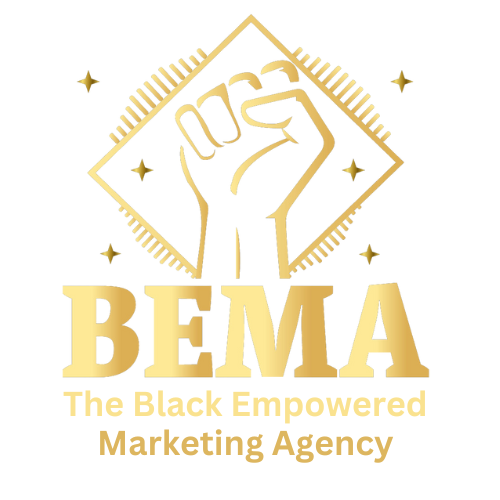Website Woes: Common Design Mistakes Black-Owned Businesses Make That Hurt Credibility
In the bustling marketplace of today, your website is often the very first handshake, the first impression, the virtual front door to your business. For Black-owned businesses aiming to build trust, connect with their community, and compete effectively, that digital first impression isn't just important – it's critical. A potential customer landing on your site makes near-instant judgments about your professionalism, reliability, and the quality you offer, all based on what they see and experience.
Too often, passionate Black entrepreneurs invest heavily in perfecting their products or services but overlook the profound impact of their website's design. We're not just talking about pretty colors; we're talking about fundamental design choices that directly influence perception and trust. Poor design choices can inadvertently signal unprofessionalism, lack of attention to detail, or even untrustworthiness, effectively locking that digital front door and turning potential customers away before you ever get a chance to truly engage them.
At BEMA - The Black Empowered Marketing Agency, we've been dedicated to helping Black-owned businesses unlock their digital potential and maximize their marketing results since 2020. We've seen countless examples of incredible businesses held back by easily fixable website design flaws. We understand that your website needs to do more than just exist; it needs to build confidence, reflect your unique brand story, and ultimately, convert visitors into loyal customers.
Let's diagnose some of the most common and damaging website design mistakes we see Black-owned businesses make – mistakes that directly hurt credibility and hinder growth.
Why Website Design IS Credibility for Black-Owned Businesses
Before we dive into the specific mistakes, let's be clear: website design is inextricably linked to credibility.
- Professionalism Proxy: Users subconsciously associate a clean, modern, well-functioning website with a professional, reliable, and competent business. Conversely, a sloppy or outdated site suggests the business itself might be disorganized or lacking.
- Trust Signal: Good design fosters trust. It shows you care about the user experience and have invested in presenting your business properly. Poor design creates friction and doubt.
- Brand Reflection: Your website's visual identity – colors, fonts, imagery, layout – communicates your brand's personality and values. Inconsistent or unprofessional design sends confusing or negative brand messages.
- Overcoming Bias: Let's be candid. In some markets, Black-owned businesses may face implicit biases. A highly professional, polished, and credible online presence isn't just beneficial; it can be essential to level the playing field and immediately establish legitimacy and trustworthiness.
Now, let's look at the specific design woes that could be undermining your credibility:
Mistake 1: Outdated or Unprofessional Visual Appearance
- The Problem: Your website looks like a relic from a bygone internet era (think early 2000s). It uses jarring or clashing color schemes, unprofessional fonts (yes, Comic Sans is still out there!), pixelated or low-quality graphics, crowded layouts, or inconsistent styling from page to page.
- The Credibility Impact: This is an instant credibility killer. It signals that the business is either out of touch, lacks attention to detail, or isn't invested enough in its online presence. Visitors may question if the business is even still active or capable of delivering quality products/services. It creates an immediate urge to click away.
- The Fix: Embrace modern design principles: clean layouts, strategic use of white space, a professional and cohesive color palette, and readable, professional typography. Invest in high-quality graphics and ensure visual consistency across your entire site. If design isn't your forte, hiring a professional web designer is a worthwhile investment.
Mistake 2: Poor Mobile Responsiveness & Experience
- The Problem: Your website might look acceptable on a large desktop monitor, but on a smartphone or tablet, it falls apart. Text is microscopic, requiring excessive zooming and scrolling. Buttons are too small to tap accurately. Images overlap text. Pages load at a crawl. Navigation menus are unusable.
- The Credibility Impact: With a majority of web traffic now coming from mobile devices, a poor mobile experience is simply unacceptable. It tells users you haven't kept up with technology and don't prioritize their experience. It leads to immediate frustration and abandonment. Google also heavily penalizes non-mobile-friendly sites in search rankings, hurting your visibility.
- The Fix: Ensure your website uses a responsive design, meaning it automatically adapts its layout and content to fit any screen size perfectly. Prioritize mobile speed by optimizing images and code. Test your site thoroughly on various actual devices (not just simulators) to ensure flawless navigation and readability. Make phone numbers click-to-call and forms easy to complete on a small screen.
Mistake 3: Low-Quality or Inauthentic Imagery
- The Problem: Your website features blurry, stretched, or pixelated images. Worse, it relies heavily on generic, cheesy stock photos that bear no resemblance to you, your team, your actual products/services, or the community you serve. The images feel impersonal and disconnected.
- The Credibility Impact: Low-quality images scream unprofessionalism. Generic stock photos fail to build any real human connection or trust. For Black-owned businesses, this is a massive missed opportunity to showcase the real faces behind the brand, build relatability, and authentically connect with your target audience. It can make your business feel less legitimate or even disingenuous.
- The Fix: Use only high-resolution images. Invest in professional photography – showcase yourself, your team (if applicable), your workspace, your products, or your services in action. Authenticity resonates deeply. If you must use stock photos, choose high-quality, natural-looking images that genuinely align with your brand identity and accurately reflect the diversity and experience of your intended audience.
Mistake 4: Confusing or Illogical Navigation (Poor UX)
- The Problem: Your website's menu structure is a maze. Visitors click aimlessly, unable to find basic information like services offered, pricing (if applicable), contact details, or how to purchase/book. Links might be mislabeled or buried under obscure headings.
- The Credibility Impact: Confusion equals frustration, and frustration equals lost customers. If users can't easily find what they need within a few seconds, they will assume your business is equally disorganized and will leave. Poor navigation signals a lack of consideration for the user experience, damaging trust.
- The Fix: Plan your site structure logically from the user's perspective. Use clear, concise, and intuitive labels for your navigation menu (e.g., "Services," "About Us," "Contact," "Shop"). Ensure essential information is easily accessible, ideally within one or two clicks from the homepage. Implement a search bar if your site has significant content.
Mistake 5: Cluttered Layout & Information Overload
- The Problem: Pages are densely packed with text, with little visual relief. Multiple competing elements (banners, buttons, images, text blocks) vie for attention simultaneously. There's a distinct lack of "breathing room" or white space. Aggressive or poorly timed pop-ups disrupt the experience.
- The Credibility Impact: A cluttered website feels overwhelming, chaotic, and unprofessional. It makes information difficult to read and digest, causing cognitive overload for the visitor. It suggests a lack of focus and clarity, which can reflect negatively on the business itself.
- The Fix: Embrace white space! It improves readability and gives your design a clean, professional feel. Break up long paragraphs with headings, subheadings, bullet points, and relevant, high-quality images. Ensure a clear visual hierarchy, guiding the user's eye to the most important information first. Use pop-ups sparingly and ensure they are easy to dismiss and offer genuine value.
Mistake 6: Inconsistent Branding Elements
- The Problem: Your website uses different versions of your logo, conflicting color palettes on different pages, a jumble of different fonts, or a tone of voice in the copy that shifts inconsistently. Your website's branding doesn't match your social media profiles or other marketing materials.
- The Credibility Impact: Inconsistency looks amateurish and unprofessional. It confuses visitors, weakens brand recognition, and suggests a lack of attention to detail – eroding trust in the overall quality of your business. A cohesive brand identity signals stability and professionalism.
- The Fix: Develop clear brand guidelines defining your logo usage, primary and secondary color palettes, typography (choose 2-3 professional fonts), and brand voice. Apply these guidelines consistently across every single page of your website and all other digital marketing channels.
Mistake 7: Hidden Contact Information & Weak Calls to Action
- The Problem: A potential customer is interested, but they can't easily find your phone number, email address, or physical location (if relevant). Worse, there are no clear prompts telling them what action to take next.
- The Credibility Impact: Making it hard for people to contact you is terrible for business and looks unprofessional. If a visitor can't figure out how to take the next step (buy, book, inquire), they'll assume the process is difficult or that you aren't eager for their business.
- The Fix: Display your primary contact information (phone, email) prominently, often in the website header and footer, and on a dedicated contact page with a map if applicable. Integrate clear, compelling Call-to-Action (CTA) buttons throughout your site (e.g., "Shop Our Collection," "Request Your Free Quote," "Schedule an Appointment," "Contact Us Today"). Make it effortless for users to connect.
Mistake 8: Technical Glitches, Broken Links & Slow Load Speed
- The Problem: Visitors encounter broken links leading to "404 Not Found" errors. Contact forms fail to submit properly. Images are missing or fail to load. Crucially, pages take more than a few seconds to load.
- The Credibility Impact: Technical problems signal neglect and incompetence. Broken elements frustrate users immensely and make your business look unreliable. Slow load speed is particularly damaging – users have zero patience for slow websites, and Google penalizes slow sites in search rankings, directly impacting your visibility and perceived quality.
- The Fix: Choose reliable, high-quality website hosting. Regularly audit your site for broken links and test all forms and interactive elements. Optimize image file sizes to improve load times. Use tools like Google PageSpeed Insights to diagnose and fix speed issues. Ongoing website maintenance is essential.
The Cumulative Damage: A Barrier to Trust and Growth
Individually, these mistakes are problematic. Collectively, they build a formidable barrier. A website that looks outdated, doesn't work on mobile, uses generic photos, is hard to navigate, and loads slowly sends an overwhelmingly negative message. It undermines the hard work, passion, and quality that you pour into your actual business operations. For Black-owned businesses, where building trust and showcasing excellence is paramount, these digital shortcomings can be particularly detrimental.
Building a Website That Empowers: The BEMA Approach
At BEMA - The Black Empowered Marketing Agency, we specialize in dismantling these barriers for Black-owned businesses. Since 2020, we’ve focused on creating digital platforms that don’t just look good, but actively build credibility, foster connection, and drive measurable results. We understand that an effective website for a BOB needs to be:
- Professionally Polished: Reflecting the quality and expertise of your business.
- Authentically Resonant: Showcasing your unique story and connecting with your community.
- Technically Sound: Fast, secure, and flawless on all devices.
- User-Centric: Easy to navigate and designed for conversions.
- Credibility-Focused: Integrated with trust signals like testimonials and clear calls to action.
We combine strategic design with a deep understanding of your audience to build websites that open doors, not lock them.
Your Website is Your Welcome Mat
Think of your website as the welcome mat and lobby for your business. Does it invite people in? Does it make them feel confident and comfortable? Or does it present obstacles and raise doubts? The design mistakes outlined here are common, but they are fixable. Investing in a professional, user-friendly, and authentic website isn't just an expense; it's a fundamental investment in your brand's credibility, reputation, and ultimately, its success.
Stop letting website woes undermine your hard work. Take an honest look at your digital front door and identify areas for improvement.
Ready to transform your website from a liability into your most powerful credibility-building asset?
Contact BEMA - The Black Empowered Marketing Agency
today for a comprehensive website audit or consultation. Let's build a digital presence that truly empowers your Black-owned business to thrive.
THE BEMA SUCCESS BLOG






